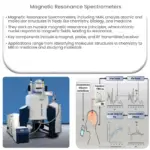MRI uses magnetic induction to manipulate protons, create signals through magnetic relaxation, and generate high-resolution images of internal structures.
How MRI Uses Magnetic Induction to Generate Images of the Body’s Internal Structures
Magnetic Resonance Imaging (MRI) is a non-invasive medical imaging technique that generates high-resolution images of the body’s internal structures. It relies on magnetic induction, which manipulates the magnetic properties of atomic nuclei, to create images.
Principles of Nuclear Magnetic Resonance and Magnetic Induction
MRI is based on the principles of nuclear magnetic resonance (NMR), a phenomenon that occurs when certain atomic nuclei absorb and re-emit electromagnetic radiation in the presence of a magnetic field. The most common nucleus used in MRI is the hydrogen nucleus, or proton, which is abundant in the body’s water molecules.
Magnetic induction is the process through which a magnetic field is produced within an object or region due to changes in the magnetic environment. In MRI, magnetic induction is used to manipulate the protons’ magnetic properties and generate images.
Main Magnetic Field and Proton Alignment
An MRI scanner contains a strong primary magnetic field, typically produced by a superconducting magnet. This field aligns the magnetic moments of the protons within the body. The protons’ alignment creates a net magnetization in the direction of the main magnetic field.
Radiofrequency Pulses and Magnetic Excitation
When a radiofrequency (RF) pulse is applied, it creates a secondary magnetic field, causing the protons to absorb energy and flip to a higher energy state. This process, known as magnetic excitation, is a direct result of magnetic induction.
Magnetic Relaxation and Signal Detection
After the RF pulse is turned off, the protons release the absorbed energy and return to their original alignment with the primary magnetic field. This process, called magnetic relaxation, generates a measurable signal. The relaxation times (T1 and T2) vary for different tissues, enabling differentiation of various anatomical structures and pathological conditions.
Gradient Coils and Image Formation
Gradient coils are used to create additional magnetic fields that vary linearly in strength across the imaging volume. These fields are superimposed on the primary magnetic field, altering the precession frequencies of the protons. By applying gradient fields in different directions (x, y, and z), spatial information can be encoded into the NMR signal.
- First, the slice selection gradient is applied, determining the specific imaging plane.
- Next, the phase encoding gradient is applied, encoding spatial information in one direction.
- Finally, the frequency encoding gradient is applied, encoding spatial information in the orthogonal direction.
Combining the signals obtained through these processes and using Fourier transformations, the final MRI image is reconstructed, providing detailed insights into the internal structure of the body.
Conclusion
MRI uses magnetic induction to manipulate protons’ magnetic properties, generating signals that are used to create high-resolution images of the body’s internal structures. By understanding the role of magnetic induction in MRI, we can appreciate the capabilities and limitations of this powerful diagnostic tool.




